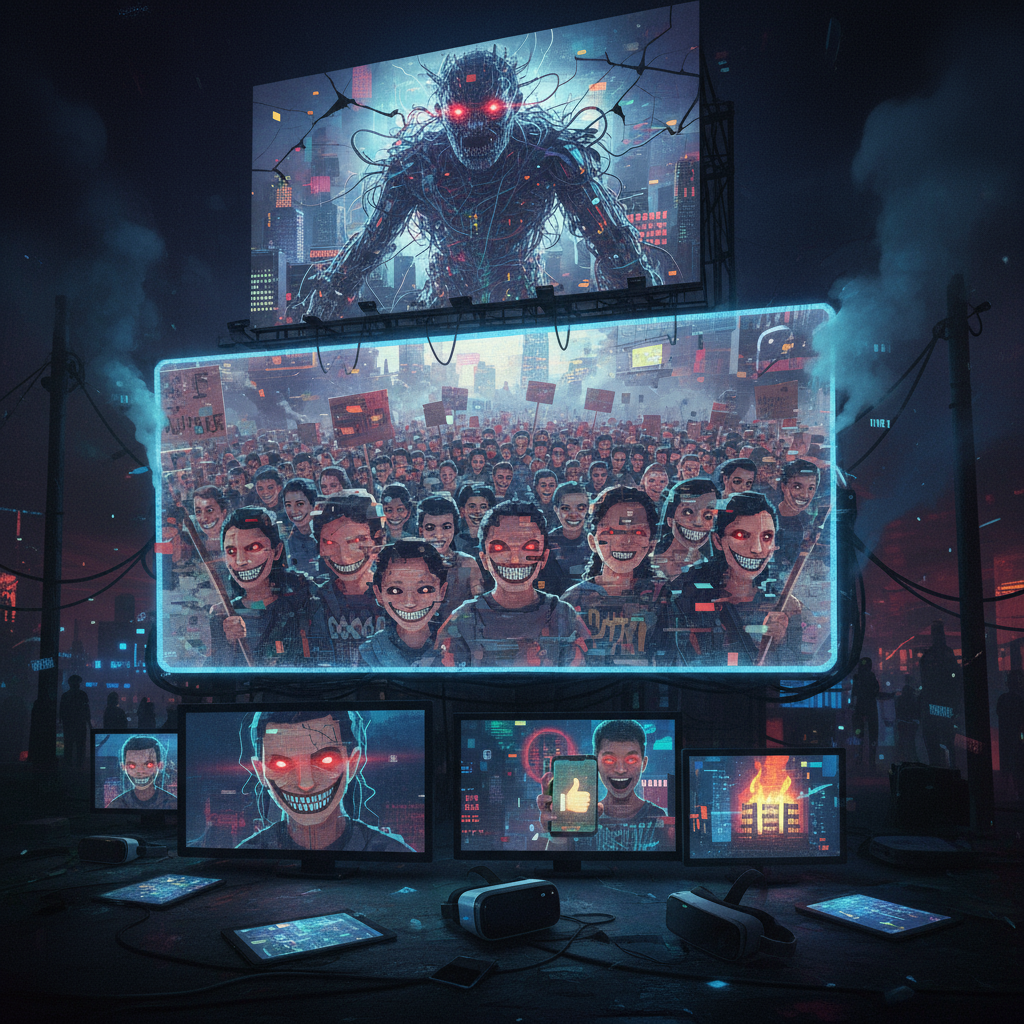The Chilling Rise of AI-Generated “Protests” and the Normalization of Political Sadism

In an increasingly polarized world, the lines between truth and fiction are blurring at an alarming rate, often accelerated by unchecked digital propagation. The latest and most disturbing trend to emerge from the darker corners of the internet involves the creation and viral spread of fake protest videos, meticulously crafted using artificial intelligence. These “AI slop” creations, as they’ve been aptly dubbed, are not merely misinformation; they are a calculated act of digital aggression, designed to incite and solidify a culture of political sadism within certain ideological bubbles, particularly what’s often referred to as “MAGA world.” The casual use of phrases like “I voted for this” in response to fabricated brutality against political opponents signals a dangerous normalization of cruelty that demands our immediate attention.
The Deceptive Allure of AI-Generated Content
Artificial intelligence, while a powerful tool for progress, has also become a potent weapon in the arsenal of disinformation. Deepfake technology and advanced generative AI models can now create incredibly realistic videos and images that are virtually indistinguishable from genuine footage to the untrained eye. This capability is being weaponized to produce “protest videos” that depict scenes not rooted in reality. These aren’t just poorly faked images; they are sophisticated productions that can manipulate public perception, stoke fear, and reinforce existing biases.
The appeal of these fake videos is insidious. For those already predisposed to distrust mainstream media or to believe conspiracy theories, these AI-generated protests serve as “proof” of their narratives. They tap into existing anxieties and confirm preconceived notions, no matter how outlandish. The speed at which these videos can be created and disseminated across social media platforms means that by the time fact-checkers can debunk them, the damage has often already been done. The emotional impact precedes the intellectual verification, leaving lasting impressions that are hard to erase.
“I Voted For This”: A disturbing Marker of Digital Sadism
Perhaps even more unsettling than the fake videos themselves is the accompanying rhetoric. The phrase “I voted for this,” once a declaration of deliberate support for a policy or outcome, has been twisted into a perverse affirmation of schadenfreude. When something “particularly brutal” happens to political opponents – whether real or, increasingly, AI-generated – this phrase is deployed by some far-right supporters as a badge of honor, a casual celebration of perceived suffering. This isn’t about policy debate or ideological victory; it’s about the dehumanization of the “other” and the enjoyment of their misfortune.
This behavior isn’t just a byproduct of online anonymity; it’s indicative of a deeper societal sickness. It speaks to a growing faction that finds gratification in the distress of those they disagree with politically. When AI-generated content depicting fictional brutality is met with fervent approval and expressions of sadistic pleasure, it suggests a dangerous detachment from reality and empathy. It reveals a landscape where the “ownership” of an election outcome is directly linked to the suffering of the opposing side, creating a cycle of resentment and anger that is incredibly difficult to break.
The Erosion of Trust and the Fabric of Democracy
The proliferation of AI-generated fake protest videos, coupled with the chilling “I voted for this” sentiment, poses a grave threat to the very foundations of democratic discourse. When reality itself can be manufactured and weaponized, trust in institutions, media, and even fellow citizens begins to erode. How can a society function effectively when its members cannot agree on a shared set of facts, or when they actively celebrate the fictitious downfall of their political rivals?
This environment fosters an echo chamber effect, where individuals are constantly fed information that validates their existing beliefs, regardless of its veracity. The emotional resonance of these AI-generated videos, designed to provoke strong reactions, becomes more compelling than genuine evidence. This makes constructive dialogue and compromise nearly impossible, as each side operates within its own fabricated reality, demonizing the other as an enemy to be conquered, not a political opponent to be debated. The long-term consequences are a fractured society, susceptible to manipulation and increasingly prone to real-world animosity and violence.
Combating Digital Deceit and Political Cruelty
Addressing this escalating problem requires a multi-faceted approach. First, technology companies must step up their game, investing heavily in AI detection tools and implementing stricter content moderation policies. While challenging, identifying and removing AI-generated disinformation is crucial. Transparency labels for AI-created content could also help users distinguish between real and synthetic media.
Second, media literacy education is paramount. Citizens must be equipped with the critical thinking skills to identify misleading content, question sources, and understand the motivations behind its creation. This includes teaching people to recognize the subtle tells of AI-generated content and to be wary of emotionally manipulative narratives. Finally, and perhaps most importantly, there needs to be a collective pushback against the normalization of political sadism. Leaders, influencers, and everyday citizens alike must condemn the celebration of fictional or real suffering and reaffirm the importance of empathy, respect, and constructive engagement in political discourse. Rebuilding a shared sense of humanity, even amidst disagreement, is essential for a healthy society.
Conclusion
The rise of fake protest videos fueled by AI, and the disturbing “I voted for this” rhetoric, are more than just internet trends; they are symptoms of a profound crisis in our information ecosystem and our political culture. They represent a dangerous leap towards digital sadism, where technology is used to fabricate suffering and validate cruelty. Turning a blind eye to this phenomenon is not an option. We must actively work to identify, debunk, and resist these sophisticated forms of disinformation and the toxic sentiment they foster. Our shared future depends on our ability to discern truth from AI-generated fiction, and to reaffirm our commitment to a politics rooted in reality and human decency, not digital cruelty.

